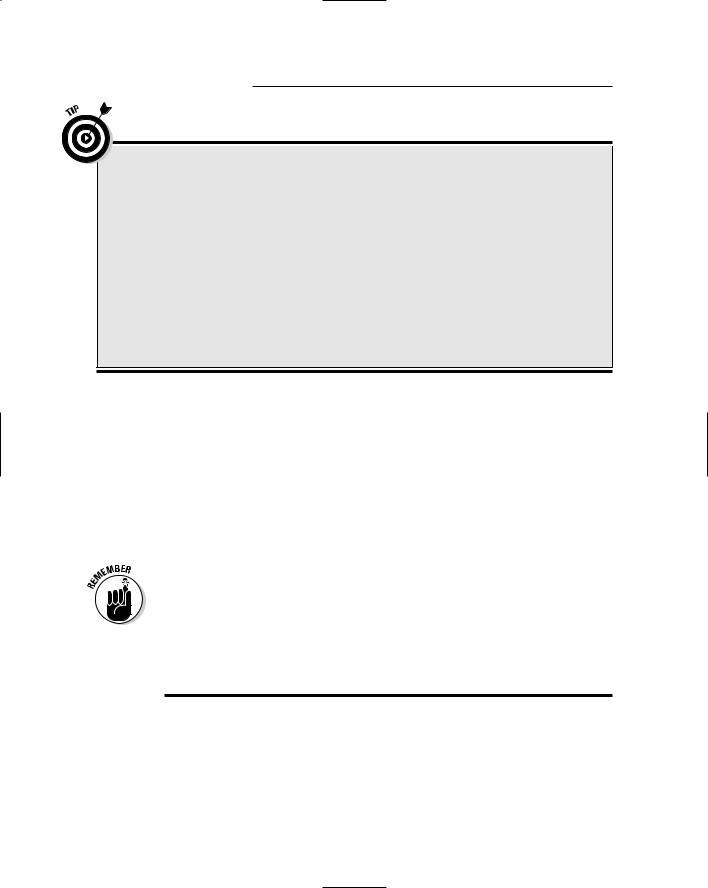
Arabic_for_Dummies
.pdf
66 |
Part II: Arabic in Action |
Table 4-1 (continued)
Arabic |
Pronunciation |
Translation |
‘ahl az-zawj |
ahel az-zah-weh-j |
in-laws (M; collective) |
|
|
|
‘ahl az-zawja |
ahel az-zah-weh-jah |
in-laws (F; collective) |
|
|
|
Hamou |
hah-mooh |
father-in-law |
|
|
|
Hamaat |
hah-maht |
mother-in-law |
|
|
|
silf |
see-lef |
brother-in-law |
|
|
|
silfa |
see-leh-fah |
sister-in-law |
|
|
|
rabboun |
rah-boon |
stepfather |
|
|
|
rabba |
rah-bah |
stepmother |
|
|
|
‘akh min al-’ab |
ah-kh-eh min al-ah-b |
stepbrother from the father’s |
|
|
side |
‘ukht min al-’ab |
oo-khe-t min al-ah-b |
stepsister from the father’s |
|
|
side |
|
|
|
‘akh min al-’umm |
ah-kh-eh min al-oo-m |
stepbrother from the mother’s |
|
|
side |
|
|
|
‘ukht min al-’umm |
oo-khe-t min al-oo-m |
stepsister from the mother’s |
|
|
side |
The role of family in Arab culture
The ‘usra plays a very important role in Arab life, society, and culture, and the Arab ‘usra structure is very different than the Western family unit. The notion of the ‘usra is much more comprehensive and reinforced in the Arab world and the Middle East than it is in America or other Western countries. The family unit most prevalent in the West is the nuclear family — generally comprised of two parents and their children — but the ‘usra in the Arab world is an extended, close-knit family network made up of parents, children, grandparents, aunts, uncles, and cousins.
It’s not uncommon to find an Arab household in which children live not only with their parents but also with their aunts and uncles, cousins, and grandparents. In Arab culture, the idea of the immediate family extends to secondand even third-degree cousins! In addition, lineage is important, and the terms for family relatives are specifically designed to differentiate between cousins from the mother’s side (‘ibn alkhaal) and cousins from the father’s side (‘ibn al-’amm). Thus, if you’re talking to an Arab about his or her family, you can be sure that you’ll have a lot to talk about!

Chapter 4: Getting to Know You: Making Small Talk 67
Talkin’ the Talk
Hassan is on a flight to New York from Casablanca, Morocco. He strikes up a conversation with Alexandra, who is sitting next to him.
Hassan: ‘afwan. hal ‘anti ‘amriikiiyya? ah-feh-wan. hal ahn-tee am-ree-kee-yah?
Excuse me. Are you American?
Alexandra: na’am ‘anaa ‘amriikiiyya. wa ‘anta?
nah-am ah-nah am-ree-kee-yah. wah ahn-tah?
Yes, I’m American. And you?
Hassan: ‘anaa maghriibii. hal zurti ‘usra fii al-maghrib? ah-nah mah-gree-bee. hal zoo-reh-tee oos-rah fee al-mah-rib?
I’m Moroccan. Were you visiting family in Morocco?
Alexandra: na’am. khaalatii fii Tanja. ‘ayna sa-tadh-hab fii
‘amriikaa?
nah-am. kah-lah-tee fee tah-neh-jah. eh-yeh-nah sah-tah-zeh-hab fee am-ree-kah?
Yes. My aunt lives in Tangiers. What part of the United States are you visiting?
Hassan: sa-’azuuru ‘akhii fii nyuu yoork. sah-ah-zuu-ru ah-kee fee noo york.
I’m going to visit my brother in New York.
Alexandra: Safar sa’eed. sah-far sah-eed.
Have a safe trip.
Hassan: kadhaalika ‘anti. kah-zah-lee-kah ahn-tee.
Same to you.

68 |
Part II: Arabic in Action |
Words to Know
ziyaara |
zee-yah-rah |
visit |
‘azuuru |
ah-zoo-roo |
I visit |
safar |
sah-far |
trip |
kadhaalika |
kah-zah-lee-kah |
same/similar |
sa’eed |
sah-eed |
safe/happy |
Making Small Talk on the Job
You can generally find out a lot about a person based on his or her mihna (meeh-nah; job). A lot of people identify themselves with their occupations, so being able to make small talk about jobs is essential.
Professions in Arabic always have a gender distinction. If you want to ask someone about his or her profession, you have two options:
maa mihnatuka? (maah meeh-nah-too-kah; What is your job?; literally “What do you do?”) (M)
maa mihnatuki? (maah meeh-nah-too-kee; What is your job?; literally “What do you do?”) (F)
‘ayna ta’mal? (eh-yeh-nah tah-mal; Where do you work?) (M)
‘ayna ta’maliina? (eh-yeh-nah tah-mah-lee-nah; Where do you work?) (F)
Table 4-2 contains some important words relating to different occupations.
Table 4-2 |
|
Professions |
Arabic |
Pronunciation |
Translation |
maSrafii |
mah-srah-fee |
banker (M) |
|
|
|
SaHafii |
sah-hah-fee |
journalist (M) |
|
|
|
kaatib |
kah-teeb |
writer (M) |
|
|
|

|
|
Chapter 4: Getting to Know You: Making Small Talk |
69 |
|
|
|
|||
|
|
|
|
|
|
Arabic |
Pronunciation |
Translation |
|
|
mumathil |
moo-mah-theel |
actor (M) |
|
|
|
|
|
|
|
muhandis |
moo-han-dees |
architect (M) |
|
|
|
|
|
|
|
Tabiib |
tah-beeb |
doctor (M) |
|
|
|
|
|
|
|
fannaan |
fah-nan |
artist (M) |
|
|
|
|
|
|
|
mughannii |
moo-gah-nee |
singer (M) |
|
|
|
|
|
|
|
mutarjim |
moo-tar-jeem |
translator (M) |
|
|
|
|
|
|
|
mumarriD |
moo-mah-reed |
nurse (M) |
|
|
|
|
|
|
|
muHaamii |
moo-hah-mee |
lawyer (M) |
|
|
|
|
|
|
|
Tabbaakh |
tah-bah-kh |
cook (M) |
|
|
|
|
|
|
|
taajir |
tah-jeer |
merchant (M) |
|
|
|
|
|
|
|
muHaasib |
moo-hah-seeb |
accountant (M) |
|
|
|
|
|
|
|
simsaar |
seem-sahr |
broker (M) |
|
|
|
|
|
|
|
Hallaaq |
hah-lahk |
barber (M) |
|
|
|
|
|
|
|
fallaaH |
fah-lah |
farmer (M) |
|
|
|
|
|
|
|
raaqiS |
rah-kees |
dancer (M) |
|
|
|
|
|
|
|
shurTii |
shoor-tee |
police officer (M) |
|
|
|
|
|
|
|
‘iTfaa’ii |
eet-fah-ee |
fireman |
|
|
|
|
|
|
|
rajul ‘a’maal |
rah-jool ah-maal |
businessman |
|
|
|
|
|
|
Table 4-2 gives the masculine forms of professions. You’ll be pleased to know that converting the masculine forms of professions into the feminine forms involves simply adding a fatHa to the end of the masculine profession. For example, to say “translator” in the feminine, you add a fatHa to muTarjim to get muTarjima (moo-tar-jee-mah; translator) (F).

70 |
Part II: Arabic in Action |
Talkin’ the Talk
Hassan and Amanda, two passengers on a plane from Casablanca to New York, are talking about their respective jobs.
Alexandra: maa mihnatuka?
maah meeh-nah-too-kah?
What do you do?
Hassan: ‘anaa muhandis fii dar al-baydaa’. ah-nah moo-han-dees fee dar al-bay-dah.
I’m an architect in Casablanca.
Alexandra: haadhaa mumtaaz! hah-zah moom-taz!
That’s excellent!
Hassan: wa ‘anti, ‘ayna ta’maliina?
wah ahn-tee, eh-yeh-nah tah-mah-lee-nah
And you, where do you work?
Alexandra: ‘anaa SaHafiyya. ah-nah sah-hah-fee-yah.
I’m a journalist.
Hassan: ma’a ‘ayy jariida? mah-ah ay jah-ree-dah?
With which newspaper?
Alexandra: ma’a nyuu yoork taymz. mah-ah noo-york tie-mez. With The New York Times.
Talking About Hobbies
hiwaayaat (hee-wah-yat; hobbies) are a really great topic for kalaam khafiif. Almost everyone has a hobby, and because a hobby, by definition, is an activity that a person is really passionate about, you can be sure that he or she will enjoy talking about it! People really like to talk about their hobbies, so knowing how to engage in kalaam khafiif related to hiwaayaat is important. Here are some activities that may be considered hiwaayaat:
raqS (rah-kes; dancing)
ghinaa’ (ree-nah; singing)

Chapter 4: Getting to Know You: Making Small Talk 71
kurat al-qadam (koo-raht al-kah-dam; soccer)
qiraa’a (kee-rah-ah; reading)
darraaja (dah-rah-jah; bicycling)
Tayyaarat waraq (tah-yah-raht wah-rak; kite flying)
Talkin’ the Talk
Yassin and Youssef, two freshmen students at al-azhar University, find that they have a hobby in common.
Yassin: maa hiya hiwaayatuka?
mah hee-ya hee-wah-yah-too-kah?
What is your hobby?
Youssef: ‘anaa ‘uHibbu kurat al-qadam.
an-nah oo-hee-boo koo-raht al-kah-dam.
I like soccer.
Yassin: ‘anaa ‘uHibbu kurat al-qadam ‘ayDan!
an-nah oo-hee-boo koo-raht al-kah-dam ay-dan!
I also like soccer!
Youssef: yajib ‘an nal’abahaa!
yah-jeeb ahn nah-luh-aba-haa!
We must play sometime!
Yassin: Taba’an!
Tah-bah-an!
Definitely!
Shooting the Breeze: Talking About
the Weather
If you want to engage in kalaam khafiif, shoot the breeze, or chitchat with a friend or stranger, talking about Taqs (tah-kes; weather) is a pretty safe topic. In conversations about Taqs, you’re likely to use some of the following words:

72 |
Part II: Arabic in Action |
shams (shah-mes; sun)
maTar (mah-tar; rain)
ra’d (rah-ed; thunder)
barq (bah-rek; lightning)
suHub (soo-hoob; clouds)
Harara (hah-rah-rah; temperature)
daraja (dah-rah-jah; degrees)
bard (bah-red; cold)
sukhoun (suh-koon; hot)
ruTuuba (roo-too-bah; humidity)
riiH (ree-eh; wind)
‘aaSifa (ah-tee-fah; storm)
thalj (thah-lej; snow)
qawsu quzaH (kah-wuh-suh koo-zah; rainbow)
If you want to express the temperature, as in “It’s x degrees,” you must use the following construct: al-Harara (insert number) daraja. So, al-Harara 35 daraja means “It’s 35 degrees.”
Because the weather is a quasi-universal topic that interests almost everyone, here are some expressions you can use to start talking about Taqs:
hal sayakun maTar al-yawm? (hal sah-yah-koon mah-tar al-yah-oum; Is it going to rain today?)
yawm sukhoun, na’am? (yah-oum suh-koon, nah-am; Hot day, isn’t it?)
‘inna yahubbu al-bard faj’atan. (ee-nah yah-hoo-boo al-bah-red fah-jeh- ah-tan; It’s gotten cold all of a sudden.)
hal sayabqaa aT-Taqs haakadhaa kul al-usbuu’? (hal sah-yab-kah at-tah- kes hah-kah-zah kool al-oos-boo; Will the weather remain like this all week?)
It would be difficult to chat about the weather without mentioning the fuSuul (fuh-sool; seasons):
Sayf (sah-yef; summer)
khariif (kah-reef; fall)
shitaa’ (shee-tah; winter)
rabii’ (rah-beeh; spring)

Chapter 4: Getting to Know You: Making Small Talk 73
Temperatures in the majority of the Middle Eastern countries are stated in Celsius and not Fahrenheit. If you hear someone say that al-harara 25 daraja (al-hah-rah-rah 25 dah-rah-jah; It’s 25 degrees), don’t worry that you’re going to freeze! They actually mean that it’s almost 80 degrees Fahrenheit. To convert degrees from Celsius to Fahrenheit, use the following formula:
(Celsius × 1.8) + 32 = Degrees Fahrenheit
Talkin’ the Talk
Alexandra and Hassan are talking about the weather.
Hassan: kayfa aT-Taqs fii nyuu yoork? keh-yeh-fah ah-tah-kes fii noo york?
How’s the weather in New York?
Alexandra: aT-Taqs mumtaaz al-’aan! ah-tah-kes moom-taz al-ahn!
The weather is excellent right now!
Hassan: hal satakun shams?
hal sah-tah-koon shah-mes?
Is it going to be sunny?
Alexandra: satakun shams kul al-’usbuu’. sah-tah-koon shah-mes kool al-oos-boo.
It’s going to be sunny all week long.
Hassan: wa ba’da dhaalika?
wah bah-dah zah-lee-kah?
And after that?
Alexandra: laa ‘a’rif. lah ah-reef.
I don’t know.

74 |
Part II: Arabic in Action |
Hurray, it’s raining!
One of the happiest times of the year for people of the Middle East is when the rain comes. After all, these hot desert countries get very little rainfall. You will almost never hear anyone complaining about rain in Arabic — there are no equivalent expressions for “rain, rain, go away.” Actually, the opposite is true! There’s a song that farmers, students, and children sing when the rain starts falling: ah shta-ta-ta-ta-ta / ‘awlaad al-Harata; Sabbi, Sabbi, Sabbi / al-’awlad fii qubbi (ah- sheh-tah-tah-tah-tah-tah / ah-ou-lad al-hah-rah-tah;
sah-bee, sah-bee, sah-bee / al-ah-ou-lad fee koobee; Oh rain, rain, rain, rain, rain / Children of the plowman; Pour, pour, pour / The children are in the hood of my jellaba). A jellaba is a long, flowing garment worn by farmers in the Middle East. It has a big hood in which the farmer puts objects. Of course, children can’t fit in the hood of the jellaba, but the hood is big enough that it symbolizes protection against the rain. This is a happy song that expresses people’s joy when it rains!
Talking Numbers
Knowing how to express numbers in Arabic is a basic language lesson. You’re bound to encounter Arabic numbers in all sorts of settings, including kalaam khafiif. For example, when you’re talking with someone about the weather, you need to know your numbers in order to reference the temperature or understand a reference if the other person makes one. In this section, I introduce you to the Arabic ‘arqaam (ah-reh-kam; numbers). (The singular form of ‘arqaam is raqm (rah-kem; number).)
Arabic ‘arqaam are part of one of the earliest traditions of number notation. Even though the Western world’s number system is sometimes referred to as “Arabic numerals,” actual Arabic ‘arqaam are written differently than the ones used in the West. One of the most important aspects of Arabic numbers to keep in mind is that you read them from left to right. That’s right! Even though you read and write Arabic from right to left, you read and write Arabic numbers from left to right! Table 4-3 lays out the Arabic ‘arqaam from 0 to 10.
Table 4-3 |
Arabic Numerals 0–10 |
|
Arabic |
Pronunciation |
Translation |
Sifr |
seh-fer |
0 |
|
|
|
waaHid |
wah-eed |
1 |
|
|
|
‘ithnayn |
eeth-nah-yen |
2 |
|
|
|
thalaatha |
thah-lah-thah |
3 |
|
|
|

|
|
Chapter 4: Getting to Know You: Making Small Talk |
75 |
|
|
|
|||
|
|
|
|
|
|
Arabic |
Pronunciation |
Translation |
|
|
‘arba’a |
ah-reh-bah-ah |
4 |
|
|
|
|
|
|
|
khamsa |
khah-meh-sah |
5 |
|
|
|
|
|
|
|
sitta |
see-tah |
6 |
|
|
|
|
|
|
|
sab’a |
sah-beh-ah |
7 |
|
|
|
|
|
|
|
thamaaniya |
thah-mah-nee-yah |
8 |
|
|
|
|
|
|
|
tis’a |
tee-seh-ah |
9 |
|
|
|
|
|
|
|
‘ashra |
ah-she-rah |
10 |
|
|
|
|
|
|
‘arqaam are important not only for discussing the weather but also for telling time, asking about prices, and conducting everyday business. Table 4-4 contains the ‘arqaam from 11 to 20.
Table 4-4 |
Arabic Numerals 11–20 |
|
Arabic |
Pronunciation |
Translation |
‘iHdaa ‘ashar |
ee-heh-dah ah-shar |
11 |
|
|
|
‘ithnaa ‘ashar |
ee-theh-nah ah-shar |
12 |
|
|
|
thalaathata ‘ashar |
thah-lah-tha-tah ah-shar |
13 |
|
|
|
‘arba’ata ‘ashar |
ah-reh-bah-ah-tah ah-shar |
14 |
|
|
|
khamsata ‘ashar |
khah-meh-sah-tah ah-shar |
15 |
|
|
|
sittata ‘ashar |
see-tah-tah ah-shar |
16 |
|
|
|
sab’ata ‘ashar |
sah-beh-ah-tah ah-shar |
17 |
|
|
|
thamaaniyata ‘ashar |
thah-mah-nee-ya-tah ah-shar |
18 |
|
|
|
tis’ata ‘ashar |
tee-seh-ah-tah ah-shar |
19 |
|
|
|
‘ishreen |
ee-sheh-reen |
20 |
|
|
|
The ‘arqaam from ‘iHdaa ‘ashar (11) to tis’ata ‘ashar (19) are obtained by combining a derivative form of the number ‘ashra (10) — specifically ‘ashar (tenth) — with a derivative form of the singular number. In the case of the
‘arqaam from thalaathata ‘ashar (13) through tis’ata ‘ashar (19), all you do is add the suffix -ta to the regular number and add the derivative form ‘ashar! After you’re familiar with this pattern, remembering these ‘arqaam is much easier.
